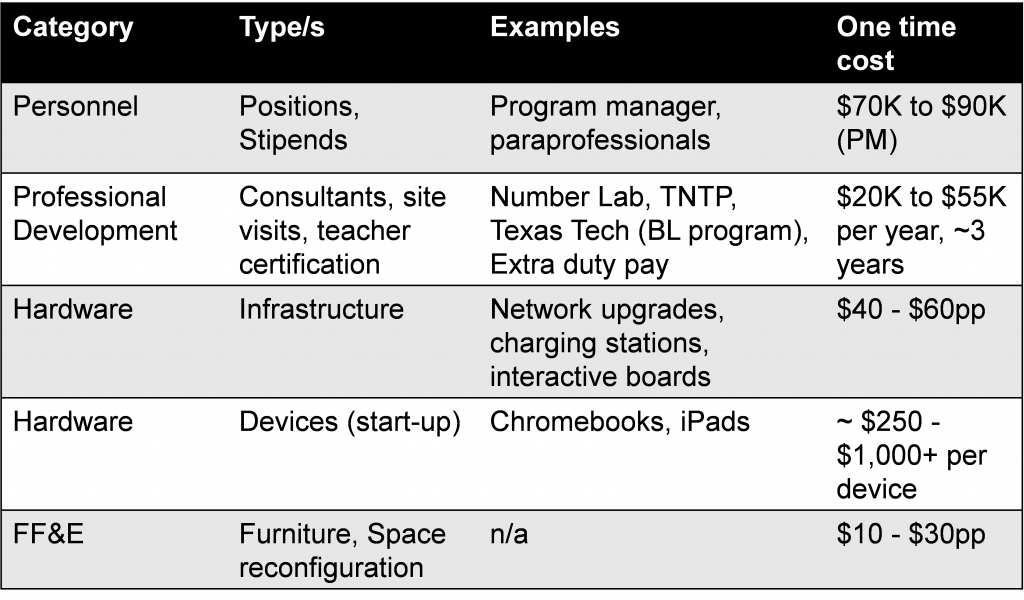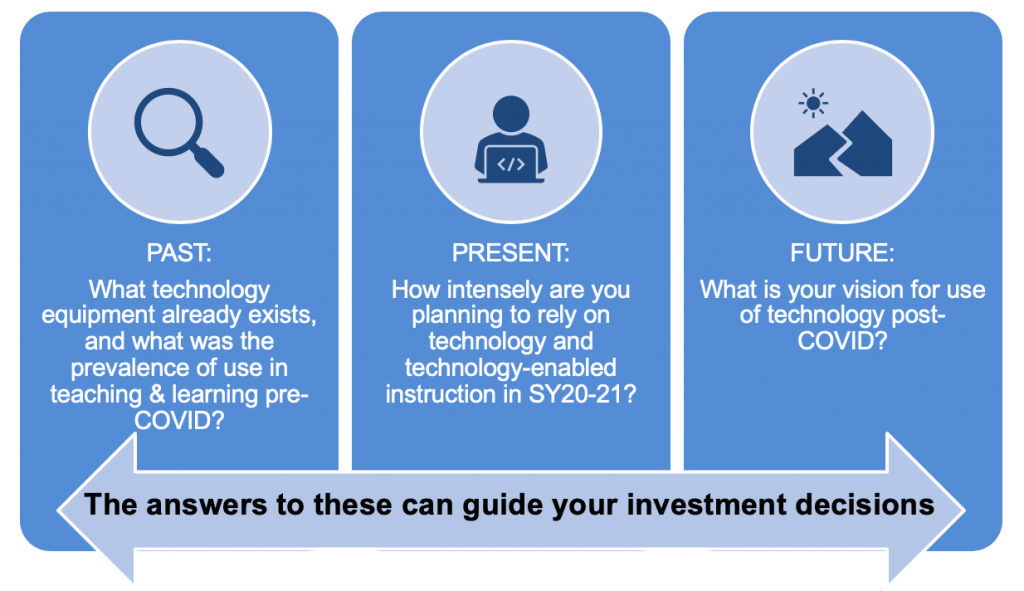While technology-enabled instruction has been growing throughout the K12 landscape over the past decade or more, it has become nearly ubiquitous with the sudden shift to distance learning due to COVID-19. Students, teachers, and parents received a crash course in the spring to varying degrees of success, and this summer has allowed schools to evaluate that experience. As SY20-21 approaches and COVID-19 risks grow, more and more cities and states across the country are anticipating delayed in-person re-openings and creating fully remote options for some or all families. For many of these schools, the financial aspects of this continuation in technology-enabled instruction remains blurry.
While the types of technology-enabled learning employed today with remote and virtual learning may change after the pandemic, the experience will inevitably have lasting effects on how instruction is delivered in a post-pandemic world. School systems have made significant investments in hardware, software, and access, all of which will be accessible beyond the pandemic. And teachers will have learned new approaches to instructional delivery and student engagement which may inform their future practices.
For school business officials and boards across the country, now is the time to ensure that your new year’s budget and procurement planning fully captures the needs of your school system as it delivers technology-enabled instruction. And now is the time to understand what longer term investments may be needed to sustain aspects of technology-enabled instruction that will be relevant beyond the pandemic.
Since 2011, Afton has worked with over 200 schools, school systems, and school leaders in developing and evaluating long-term resource plans to support innovative school models, including those incorporating technology into the classroom. While most of these school models were not the virtual classrooms being employed during COVID-19, many of them require similar resources to virtual and hybrid learning. Much can be gleaned from the investments made by these schools to assist in financial planning today. As follows, we share three primary points of advice for school systems about financial planning for technology-enabled instruction.
Invest heavily in staff and their professional development.
For many, this is a new way of instructional delivery. The most critical thing to remember is that technology does not do the teaching – it enables the teaching.
Our advice:
Ensure the budget includes a material, recurring investment in professional development and teacher collaboration and planning time. Time and time again, in our discussions with school leaders and evaluations of their financial plans, investments in additional staff and professional development to support technology-enabled instruction proved to be the most important investments.
District leaders of schools implementing technology-enabled instruction invested more than 50% of one-time and recurring funding in personnel
Following is a summary of actual and projected 5-year expenditures of Districts and Charter networks implementing technology-enabled school models. The data represent the resource allocation plans for 11 school systems, 110 schools, 850 classrooms and 36,000 students as of fiscal year 2019.

Be flexible and expect trial and error.
There will likely be some initial hardware and software choices that, when implemented, do not fully fit the needs of staff and students.
Our advice:
Ensure the budget includes a contingency for hardware and software and that procurement policies and practices are in place to enable swift course corrections. These often require significant changes in policy, but also culture shifts to ensure responsiveness, flexibility, and adaptability.
Plan now for hardware refreshes and sustaining software and professional development.
Because there are likely to be aspects of today’s pandemic-induced instruction that will forever change instructional delivery practices, school systems will need to plan for maintaining its technology and professional development investments into the future. Devices purchased during the pandemic will need to be refreshed in a few years, and there will need to be a provision for annual replacement devices. Learning management systems and instructional content may need to be enhanced or upgraded. Teachers and administrators will evolve in their use of technology as will their professional development needs. Post-pandemic, there will be school systems that will re-think how instruction should be delivered – including migrating to more competency-based approaches, changing classroom structures, and rethinking school scheduling and course offerings with a new view of in-person and virtual instruction at some grade levels. These considerations may completely change needs for school-level staffing, technology, and professional development investments.
Our advice:
Ensure you have a multi-year financial plan and include a contingency for renewing the current technology and professional development investments. As it is appropriate, begin assessing successes and opportunities that arise from this shift to technology-enabled instruction, and what implications it may have in the post-pandemic world. As you think ahead to long-term strategic planning, identify resources and services that could potentially be repurposed to meet post-pandemic instructional design opportunities.
How does this apply to your remote learning plan now?
As you think about the fall, and investments you might need to make, we can look at the types of investments that have been made by school in other models of technology-enabled instruction. Here we share the costs you can expect at the district and school level, alongside a few ideas for tradeoff considerations.
One-time costs: we define one-time costs as those that will expire or end after the school model has been fully implemented. An example of a one-time cost includes intensive professional development, or a program manager position that may be filled only during implementation, which may take anywhere from one to three years.

These findings are consistent with outcomes of a study our team led through LEAP Innovations in Chicago, wherein we evaluated the costs of implementing personalized learning across six schools. This study, Sustaining Innovation and Preparing for Scale: Financial Sustainability Research and Analysis of Personalized Learning School Models, found one-time investments ranged from $233 to $1,135 on a per pupil basis across the six schools.
Recurring costs: Our definition of recurring costs to support tech-enabled school models includes those investments that will be required to sustain these models in the long-term (i.e. after an implementation period).

Trade-offs: To fund these recurring costs, we have seen Districts employ strategies such as developing a long term staffing strategy, identifying inefficient technology spending and reallocating funding for textbooks and school supplies.
- Long-term staffing plan. We recommend each district implementing a tech-enabled school model(s) perform a review of their existing position structure to identify opportunities to create positions required for long term success of these new models (such as blended learning coaches, data specialists) while also identifying opportunities for change in their existing structure (review of job descriptions, plan for turnover, etc.). When implemented effectively, a significant component of long term funding of recurring tech-enabled needs can be sourced with this approach.
- Evaluate technology spending. Various studies have shown a significant underutilization of existing technology within school districts. Performing even a basic technology audit (such as one offered by Learn) could identify opportunities to more effectively leverage limited available funding for more impactful information technology spending.
- Reallocate existing funding. More and more districts are reallocating historical funding from supplies and textbooks to software, content and devices. There is also an opportunity to evaluate central services and determine how to best support schools utilizing technology-driven instruction through re-evaluating large major contracts.
The specific impact this has on your schools depends on your start point, your approach to SY20-21, and what you envision for the future:

Given this, as you build your financial plan, consider these specific questions:
- What is our starting point for technology? Should we (have we) conducted a technology audit?
- What supports do our teachers need? What professional development could be provided to effectively support teachers in effective use of technology for remote learning?
- What is our level of student access, and what do we need to do now to improve access (including devices, wifi, servers), if anything?
- Do we have the right blend of online/asynchronous vs. synchronous materials and content? Should we (have we) conducted a software/content audit?
- Can we improve upon student assessment and/or data systems? Should we invest in or support data-driven instruction PD or platforms for our teaching staff?
- Do we anticipate these being short-term or long-term investments?
- What sources of funding exist for one-time and recurring investments?
What have you learned about the financial aspects of remote instruction? Do these findings and recommendations ring true to you? What would you add or change? Let us know! Contact us at connect@aftonpartners.com.